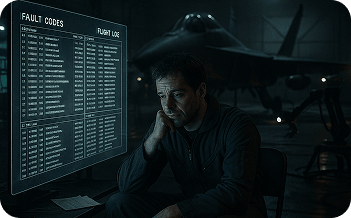Welcome to Nexaero Protocols.
This is not a game for pilots. It’s for those who keep them alive.
You are an MCT — Maintenance Control Technician — responsible for fault
diagnostics, emergency repairs, component calibration, and system
release approval. Your office? A hangar lit by flickering sodium lamps.
Your tools? A checklist, a scanner, your instinct, and not enough
time.
Every plane cleared or grounded — is your decision.
Every oversight — your weight to carry.
Your Role: Between Sky and Ground
NEXAERO places you inside an operational aerospace facility with real-time responsibilities. Your shift lasts six hours — compressed into gameplay. Tasks queue up fast, requests overlap, documentation must be complete. Lives depend on you.
Core Functions:
• Review fault reports submitted by onboard sensors or crew
• Perform subsystem diagnostics via simulated digital interface
• Validate physical repair via maintenance drone input
• Make critical release/no-release calls on scheduled flights
• Navigate pressure from Operations vs. Safety

This is not abstract clicking. You will read real manuals, interpret flight logs, match symptom codes, and fight against fatigue.
Aircraft Systems Interface
You’ll interact with:
-
AeroSimOS 4.9:
the core maintenance OS — glitchy, legacy-based, but powerful
-

Multisystem Dashboard:
real-time engine, hydraulic, avionics and pressurization stats
-
VR Check Modules:
3D simulation of known failure modes and responses
-
Tablet Toolkit:
checklists, component breakdowns, tool reservations, and unlock requests
The interface is designed to distract you when it matters most —
overlapping alerts, unreadable labels, contradictory inputs.
You must learn to prioritize.
Because the aircraft doesn’t care if you’re tired.
It will take off anyway — if you let it.
Incident Board – Critical Moments Logged
Nexaero includes scripted and procedural incidents that reflect
real-world aviation failures — and how small mistakes escalate.
Examples:
-

#017-A:
Improper sealant replacement on hydraulic panel → gear fails on taxi
-
#043-C:
Late night engine code misread → twin-prop release with latent fault
-
#122-B:
Sensor flagged oxygen leak — dismissed due to system redundancy. Post-flight pilot hospitalized
-

#008-F:
Perfect paperwork. System all green. And yet, 2 minutes after takeoff… power cascade. Did you miss something?
These are not cutscenes. They’re consequences of decisions you make under pressure.
Ground Crew Dispatches – What Techs Say
Toolkit & Procedures
To keep aircraft in the sky, you’ll use a mix of tools — both digital and manual:
-

Tool Register:
Request, reserve, return. Failure to log tools leads to audit penalties.
-

Parts Scanner:
Match barcodes to maintenance history, validate compatibility
-

Comms Link:
Coordinate with fuel, loading, ATC, and security
-

Emergency Binder:
Non-digital manual for legacy aircraft systems (yes, paper still exists here)
Each tool ties to a procedure — and each procedure includes:
• Safety Step Confirmations
• Torque Tolerances
• Environmental Adjustments (cold start rules, hangar humidity)
• Logbook Syncs
Errors compound. Miss one torque setting? That bolt walks loose on
climb-out.
The game doesn’t show you failure… until it’s airborne.